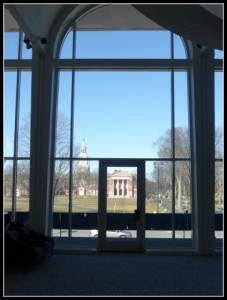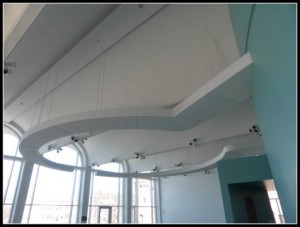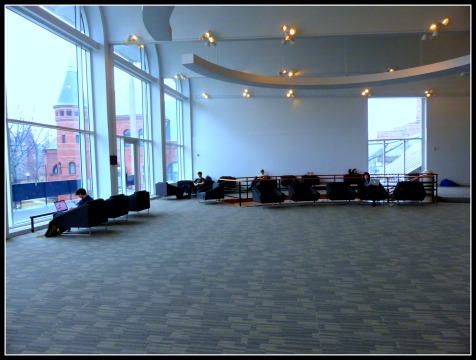
Expansive design features and lines of sight shape publicity
The most striking feature of the Top of the Hop is the wall entirely composed of floor-to-ceiling windows which flood the room with natural light. This coupled with the 30ft vaulted ceilings makes the room feel expansive and open. In this illuminated setting there is the sense of being exposed to the other occupants of the room.
Additionally, the approximately 70 x 40 ft. room is entirely uninterrupted by partitions. All furniture is positioned around the edges of the room, leaving a gaping amount of undetermined floor space in the center. Unlike other study spaces on campus, TotH has no cubbies or cubicles to separate individuals. The lack of any physical barriers to obstruct one’s view, in addition to the brightness of the space, makes lines of sight within Top of the Hop practically unlimited, meaning that, in theory, an observer standing at nearly any point in the room can see everyone and everything.

The illusion of open lines of sound makes the TotH feel public

Although never explicitly stated, it is well known and accepted that Top of the Hop is a designated quiet zone. This may in part be due to the vastness and openness of the room which create a void where it appears that sound will reverberate. This in turn may make students all the more aware of any sounds that they either purposely, or unintentionally create. Freshman Sydney Kamen echoes the opinions of other surveyed students in her statement that, when she is studying at Top of the Hop she is “afraid that any noise [she] makes will resonate in the silence”. Thus, she is especially careful not to disturb and possibly elicit “sideways glances” from her studious neighbors.
However, due to the acoustics of the room, this is an entirely imagined phenomenon. While shuffling papers and phone calls might still annoy nearby students, most noise is lost upward due to the vaulted ceilings.
This makes sense when one considers that the space is typically used for receptions and small performances. In a reception with a large crowd filling the space the chatter might become overwhelmingly loud if there was not some noise cancelling feature. Similarly, in the case of a performance the acoustics would project the music throughout the room, while still minimizing undesired background noise.
Given students’ perceptions of the space it is difficult to determine whether Top of the Hop is a quiet zone due to its incorrectly assumed open lines of sound or as a result of its strategic design.
